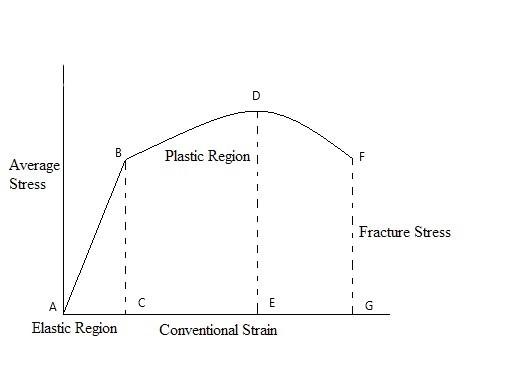
What is the type of deformation in plastic deformation?
A) Reversible
B) Permanent
C) Both
D) None
Answer
138.9k+ views
Hint:The deformation in the elastic region is reversible as the material goes back to its original shape and size on the removal of stress.
Complete step by step solution:

The above stress-strain curve is for a ductile material. In the given stress-strain curve, the part ABC represents the elastic region whereas the part BDFGEC represents the plastic region.
The point B is also known as the elastic limit or proportional limit. Point C on the x-axis represents the strain when stress corresponding to point B is applied on the material.
When stress greater than the elastic limit is applied, the material does not regain its original shape and size even after the removal of the applied stress. After the removal of stress greater than elastic limit, only elastic strain is recovered, the plastic strain remains. This strain that remains is known as a permanent set. It is not recoverable.
In brittle materials, the plastic region is smaller and the material cannot bear a stress much larger than the elastic limit of the material. However, the deformation in the plastic region of brittle materials is also non-recoverable.
Hence, plastic deformation in both brittle and ductile materials is permanent and irreversible.
Therefore, option B is the correct answer for this question.
Note: Deformation is the change in shape or size of an object. It is not the same as strain. Strain is change in dimension per unit dimension of the material or deformation per unit dimension. Deformation has the dimension of length whereas strain is dimensionless.
Complete step by step solution:

The above stress-strain curve is for a ductile material. In the given stress-strain curve, the part ABC represents the elastic region whereas the part BDFGEC represents the plastic region.
The point B is also known as the elastic limit or proportional limit. Point C on the x-axis represents the strain when stress corresponding to point B is applied on the material.
When stress greater than the elastic limit is applied, the material does not regain its original shape and size even after the removal of the applied stress. After the removal of stress greater than elastic limit, only elastic strain is recovered, the plastic strain remains. This strain that remains is known as a permanent set. It is not recoverable.
In brittle materials, the plastic region is smaller and the material cannot bear a stress much larger than the elastic limit of the material. However, the deformation in the plastic region of brittle materials is also non-recoverable.
Hence, plastic deformation in both brittle and ductile materials is permanent and irreversible.
Therefore, option B is the correct answer for this question.
Note: Deformation is the change in shape or size of an object. It is not the same as strain. Strain is change in dimension per unit dimension of the material or deformation per unit dimension. Deformation has the dimension of length whereas strain is dimensionless.
Recently Updated Pages
How to find Oxidation Number - Important Concepts for JEE

How Electromagnetic Waves are Formed - Important Concepts for JEE

Electrical Resistance - Important Concepts and Tips for JEE

Average Atomic Mass - Important Concepts and Tips for JEE

Chemical Equation - Important Concepts and Tips for JEE

Concept of CP and CV of Gas - Important Concepts and Tips for JEE

Trending doubts
JEE Main 2025 Session 2: Application Form (Out), Exam Dates (Released), Eligibility, & More

JEE Main 2025: Derivation of Equation of Trajectory in Physics

Learn About Angle Of Deviation In Prism: JEE Main Physics 2025

Electric Field Due to Uniformly Charged Ring for JEE Main 2025 - Formula and Derivation

JEE Main 2025: Conversion of Galvanometer Into Ammeter And Voltmeter in Physics

Degree of Dissociation and Its Formula With Solved Example for JEE

Other Pages
Units and Measurements Class 11 Notes: CBSE Physics Chapter 1

JEE Advanced Marks vs Ranks 2025: Understanding Category-wise Qualifying Marks and Previous Year Cut-offs

Motion in a Straight Line Class 11 Notes: CBSE Physics Chapter 2

Important Questions for CBSE Class 11 Physics Chapter 1 - Units and Measurement

NCERT Solutions for Class 11 Physics Chapter 1 Units and Measurements

NCERT Solutions for Class 11 Physics Chapter 2 Motion In A Straight Line




